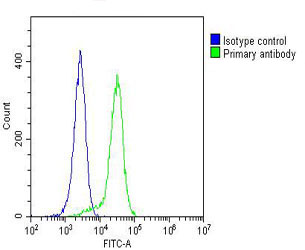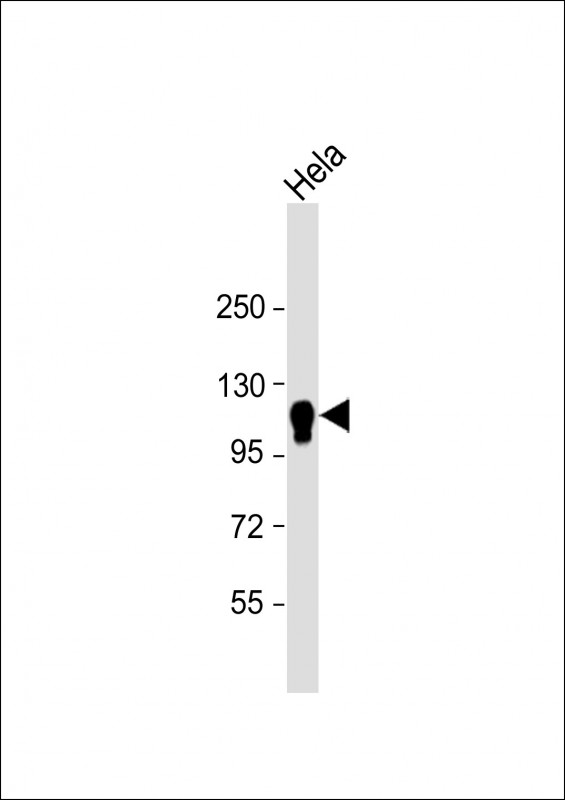CYLD Antibody
Purified Mouse Monoclonal Antibody (Mab)
- 产品详情
- 实验流程
- 背景知识
Application
| WB, FC, E |
|---|---|
| Primary Accession | Q9NQC7 |
| Reactivity | Human, Rat, Mouse |
| Host | Mouse |
| Clonality | monoclonal |
| Isotype | IgG2a,k |
| Clone Names | 1667CT857.3.6.1 |
| Calculated MW | 107316 Da |
| Gene ID | 1540 |
|---|---|
| Other Names | Ubiquitin carboxyl-terminal hydrolase CYLD, 3.4.19.12, Deubiquitinating enzyme CYLD, Ubiquitin thioesterase CYLD, Ubiquitin-specific-processing protease CYLD, CYLD, CYLD1, KIAA0849 |
| Target/Specificity | This CYLD antibody is generated from a mouse immunized with a KLH conjugated synthetic peptide between 305-582 amino acids from human CYLD. |
| Dilution | WB~~1:4000 FC~~1:25 E~~Use at an assay dependent concentration. |
| Format | Purified monoclonal antibody supplied in PBS with 0.09% (W/V) sodium azide. This antibody is purified through a protein G column, followed by dialysis against PBS. |
| Storage | Maintain refrigerated at 2-8°C for up to 2 weeks. For long term storage store at -20°C in small aliquots to prevent freeze-thaw cycles. |
| Precautions | CYLD Antibody is for research use only and not for use in diagnostic or therapeutic procedures. |
| Name | CYLD {ECO:0000303|PubMed:12917689, ECO:0000312|HGNC:HGNC:2584} |
|---|---|
| Function | Deubiquitinase that specifically cleaves 'Lys-63'- and linear 'Met-1'-linked polyubiquitin chains and is involved in NF-kappa-B activation and TNF-alpha-induced necroptosis (PubMed:18313383, PubMed:18636086, PubMed:26670046, PubMed:26997266, PubMed:27458237, PubMed:27591049, PubMed:27746020, PubMed:29291351, PubMed:32185393). Negatively regulates NF-kappa-B activation by deubiquitinating upstream signaling factors (PubMed:12917689, PubMed:12917691, PubMed:32185393). Contributes to the regulation of cell survival, proliferation and differentiation via its effects on NF-kappa-B activation (PubMed:12917690). Negative regulator of Wnt signaling (PubMed:20227366). Inhibits HDAC6 and thereby promotes acetylation of alpha-tubulin and stabilization of microtubules (PubMed:19893491). Plays a role in the regulation of microtubule dynamics, and thereby contributes to the regulation of cell proliferation, cell polarization, cell migration, and angiogenesis (PubMed:18222923, PubMed:20194890). Required for normal cell cycle progress and normal cytokinesis (PubMed:17495026, PubMed:19893491). Inhibits nuclear translocation of NF-kappa-B (PubMed:18636086). Plays a role in the regulation of inflammation and the innate immune response, via its effects on NF- kappa-B activation (PubMed:18636086). Dispensable for the maturation of intrathymic natural killer cells, but required for the continued survival of immature natural killer cells (By similarity). Negatively regulates TNFRSF11A signaling and osteoclastogenesis (By similarity). Involved in the regulation of ciliogenesis, allowing ciliary basal bodies to migrate and dock to the plasma membrane; this process does not depend on NF-kappa-B activation (By similarity). Ability to remove linear ('Met-1'-linked) polyubiquitin chains regulates innate immunity and TNF-alpha-induced necroptosis: recruited to the LUBAC complex via interaction with SPATA2 and restricts linear polyubiquitin formation on target proteins (PubMed:26670046, PubMed:26997266, PubMed:27458237, PubMed:27591049). Regulates innate immunity by restricting linear polyubiquitin formation on RIPK2 in response to NOD2 stimulation (PubMed:26997266). Involved in TNF-alpha-induced necroptosis by removing linear ('Met-1'-linked) polyubiquitin chains from RIPK1, thereby regulating the kinase activity of RIPK1 (By similarity). Negatively regulates intestinal inflammation by removing 'Lys-63' linked polyubiquitin chain of NLRP6, thereby reducing the interaction between NLRP6 and PYCARD/ASC and formation of the NLRP6 inflammasome (By similarity). Does not catalyze deubiquitination of heterotypic 'Lys-63'-/'Lys-48'-linked branched ubiquitin chains (PubMed:27746020). Removes 'Lys-63' linked polyubiquitin chain of MAP3K7, which inhibits phosphorylation and blocks downstream activation of the JNK-p38 kinase cascades (PubMed:29291351). Also removes 'Lys-63'-linked polyubiquitin chains of MAP3K1 and MA3P3K3, which inhibit their interaction with MAP2K1 and MAP2K2 (PubMed:34497368). |
| Cellular Location | Cytoplasm. Cytoplasm, perinuclear region. Cytoplasm, cytoskeleton. Cell membrane; Peripheral membrane protein; Cytoplasmic side. Cytoplasm, cytoskeleton, microtubule organizing center, centrosome. Cytoplasm, cytoskeleton, spindle. Cytoplasm, cytoskeleton, cilium basal body {ECO:0000250|UniProtKB:Q80TQ2}. Note=Detected at the microtubule cytoskeleton during interphase. Detected at the midbody during telophase. During metaphase, it remains localized to the centrosome but is also present along the spindle (PubMed:25134987) {ECO:0000250|UniProtKB:Q80TQ2, ECO:0000269|PubMed:25134987} |
| Tissue Location | Detected in fetal brain, testis, and skeletal muscle, and at a lower level in adult brain, leukocytes, liver, heart, kidney, spleen, ovary and lung. Isoform 2 is found in all tissues except kidney. |
For Research Use Only. Not For Use In Diagnostic Procedures.
Provided below are standard protocols that you may find useful for product applications.
BACKGROUND
Protease that specifically cleaves 'Lys-63'-linked polyubiquitin chains. Has endodeubiquitinase activity. Plays an important role in the regulation of pathways leading to NF-kappa-B activation (PubMed:12917689, PubMed:12917691). Contributes to the regulation of cell survival, proliferation and differentiation via its effects on NF-kappa-B activation (PubMed:12917690). Negative regulator of Wnt signaling (PubMed:20227366). Inhibits HDAC6 and thereby promotes acetylation of alpha-tubulin and stabilization of microtubules (PubMed:19893491). Plays a role in the regulation of microtubule dynamics, and thereby contributes to the regulation of cell proliferation, cell polarization, cell migration, and angiogenesis (PubMed:18222923, PubMed:20194890). Required for normal cell cycle progress and normal cytokinesis (PubMed:17495026, PubMed:19893491). Inhibits nuclear translocation of NF-kappa-B. Plays a role in the regulation of inflammation and the innate immune response, via its effects on NF-kappa-B activation (PubMed:18636086). Dispensable for the maturation of intrathymic natural killer cells, but required for the continued survival of immature natural killer cells. Negatively regulates TNFRSF11A signaling and osteoclastogenesis (By similarity). Involved in the regulation of ciliogenesis, allowing ciliary basal bodies to migrate and dock to the plasma membrane; this process does not depend on NF-kappa-B activation (By similarity).
REFERENCES
Bignell G.R.,et al.Nat. Genet. 25:160-165(2000).
Nagase T.,et al.DNA Res. 5:355-364(1998).
Nakajima D.,et al.DNA Res. 9:99-106(2002).
Zhang Q.-H.,et al.Genome Res. 10:1546-1560(2000).
Trompouki E.,et al.Nature 424:793-796(2003).
终于等到您。ABCEPTA(百远生物)抗体产品。
点击下方“我要评价 ”按钮提交您的反馈信息,您的反馈和评价是我们最宝贵的财富之一,
我们将在1-3个工作日内处理您的反馈信息。
如有疑问,联系:0512-88856768 tech-china@abcepta.com.























 癌症的基本特征包括细胞增殖、血管生成、迁移、凋亡逃避机制和细胞永生等。找到癌症发生过程中这些通路的关键标记物和对应的抗体用于检测至关重要。
癌症的基本特征包括细胞增殖、血管生成、迁移、凋亡逃避机制和细胞永生等。找到癌症发生过程中这些通路的关键标记物和对应的抗体用于检测至关重要。 为您推荐一个泛素化位点预测神器——泛素化分析工具,可以为您的蛋白的泛素化位点作出预测和评分。
为您推荐一个泛素化位点预测神器——泛素化分析工具,可以为您的蛋白的泛素化位点作出预测和评分。 细胞自噬受体图形绘图工具为你的蛋白的细胞受体结合位点作出预测和评分,识别结合到自噬通路中的蛋白是非常重要的,便于让我们理解自噬在正常生理、病理过程中的作用,如发育、细胞分化、神经退化性疾病、压力条件下、感染和癌症。
细胞自噬受体图形绘图工具为你的蛋白的细胞受体结合位点作出预测和评分,识别结合到自噬通路中的蛋白是非常重要的,便于让我们理解自噬在正常生理、病理过程中的作用,如发育、细胞分化、神经退化性疾病、压力条件下、感染和癌症。







